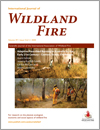International Journal of Wildland Fire
Volume 29
Numbers 4 & 5 2020
Adaptive Prescribed Burning in Australia for the Early 21st Century – Context, Status, Challenges
This introduction to the special issue Adaptive prescribed burning in Australia for the early 21st Century provides an overview of the context, status and challenges for contemporary prescribed burning in Australia. We conclude that management targets for prescribed burning should address societal and environmental needs, be capable of measuring trends in performance and reinforce an adaptive management framework.
A risk-based framework for targeting investment in prescribed burning in Western Australia is presented. The framework provides principles and a rationale for programming fuel management with indicators to demonstrate that bushfire risk has been reduced to an acceptable level. Bushfire risk is determined through a risk assessment and prioritisation process.
Using past fire records, we identified planned and unplanned fire occurrences between 2004 and 2015 in south-east Queensland. Unplanned fires covered a larger extent, were more frequent and occurred mostly in spring, whereas planned fires occurred mostly in winter. The use of accurate fire records in mapping enhances fire management capabilities.
Australia’s sparsely settled rangelands cover 78% of the nation, where contemporary fire regimes range from being infrequently burnt in the arid centre following significant rainfall events, to being frequently burnt in northern savannas following annually reliable monsoonal rains. We show that limited prescribed fire management is undertaken today, and, with reference to the Northern Territory, illustrate the immense demographic, institutional, logistical, and economic challenges involved. Proposed solutions include supporting and contracting the developing network of remote Indigenous Ranger Groups to deliver front-line preparedness and response services, building on and taking advantage of commercial savanna burning projects, and nurturing cross-sectoral and -institutional arrangements generally.
The use of a decision-making framework is demonstrated through a case study. The case study focuses on the process of selecting a long-term landscape fuel management strategy to guide operational delivery. The decision-making framework encourages stakeholder deliberation and supports decision makers to make decisions involving trade-offs of multiple values.
Arnhem Land, in northern Australia, is home to several eligible offsets projects operated by Aboriginal people utilising local Aboriginal knowledge and customary burning techniques. In this paper we evaluate these contemporary savanna burning projects in relation to the fire management aspirations of Traditional Owners.
Historically unmanaged fire regimes are implicated in the detected decline of savanna biodiversity. Analysis of a contemporary primarily carbon market funded indigenous fire management program shows that most defined ecological thresholds are being addressed. While there is room for improvement, and work is required to more appropriately define and monitor ecological fire regime thresholds, these results demonstrate what is possible through well-resourced co-operative fire management.
We present a statistical method to quantify and map wildfire spread to assets and the reduction gained by removing fuel from treatment blocks based on fire spread patterns in historical fires. The likelihood of spread to assets was highest in areas with high forest cover, but spread reduction was highest in treatment blocks at the wildland–urban interface.
We use fire behaviour simulations and Bayesian networks to estimate the risk mitigation effects of prescribed burning for area burnt, house loss, life loss, length of powerline and road damaged, and area burnt below minimum tolerable fire interval. Our methods can be used to quantify and compare risk across regions.
Fire managers need to make decisions about expenditure in a more transparent manner. Here we undertake an economic analysis of fire management in the Australian Capital Territory to identify cost-effective management approaches. Absence of fuel treatments in this landscape will increase the risk of loss in the long term.
We explored the cost and benefits of modifying the spatial arrangement of prescribed burns on public land. We found that wildland–urban (WUI) interface treatments are significantly more expensive than landscape treatments and, despite additional benefits gained from WUI treatments, in most cases, it is not the most economically efficient strategy.





